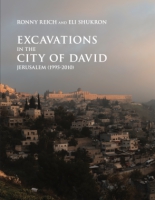
Tel Miqne 10/1
Tel Miqne-Ekron Excavations 1994–1996, Field IV Upper and Field V, The Elite Zone Part 1: Iron Age IIC Temple Complex 650
Seymour (Sy) Gitin, Steven M. Ortiz, and Trude Dothan
Tel Miqne 10/1
Tel Miqne-Ekron Excavations 1994–1996, Field IV Upper and Field V, The Elite Zone Part 1: Iron Age IIC Temple Complex 650
Seymour (Sy) Gitin, Steven M. Ortiz, and Trude Dothan
Tel Miqne-Ekron is one of the largest and most significant Iron Age archaeological sites in Israel. Based on fourteen seasons of excavations, this volume in the Tel Miqne series documents remarkable finds from the late Iron Age II Philistine temple.
- Description
- Bio
- Table of Contents
- Sample Chapters
- Subjects
An essential resource for archaeologists, biblical scholars, and historians specializing in the ancient Near East, Tel Miqne-Ekron 10/1 is of vital importance for reconstructing the history of the Southern Levant in the Iron Age.
In addition to the coauthors, the contributors include Eleanor F. Beach, David Ben-Shlomo, Baruch Brandl, Jeffrey R. Chadwick, Alexandra S. Drenka, Adi Erlich, Amir Golani, Edward F. Maher, Ianir Milevski, Alla Rabinovich, Christa SchŠfer-Lichtenberger, and Anna de Vincenz.
Seymour (Sy) Gitin is Emeritus Dorot Director and Professor of Archaeology at the Albright Institute of Archaeological Research in Jerusalem and the author of numerous volumes, including his recent memoir, The Road Taken: An Archaeologist's Journey to the Land of the Bible, also available from Eisenbrauns.
Steven M. Ortiz is Director of the Center of Archaeological Studies at Lipscomb University.
Trude Dothan (1922–2016) was Eliezer L. Sukenik Professor of Archaeology Emerita at the Hebrew University of Jerusalem. Together with Sy Gitin, she directed the fourteen seasons of excavations at the Philistine site of Tel Miqne-Ekron.
Preface
Seymour Gitin
Map of Philistine Coastal Plain and Shephelah Sites in the Iron Age
Tel Miqne-Ekron Iron Age II Stratigraphic and Chronological Chart
Tel Miqne-Ekron Field Reports and Monographs
Excavation Staff
Photos of Staff, Student Volunteers, and Workers
Abbreviations and Additional Terms Used in Pottery Reading
Introduction: Goals, Field Report, and Archives
Seymour Gitin
Chapter 1. Revised Top Plan of Tel Miqne-Ekron
Seymour Gitin and Jeffrey R. Chadwick
Chapter 2. Occupational History: The Stratigraphy and Architecture of Iron IIC Stratum IB/C and the Persian–Hellenistic, Roman–Byzantine, and Islamic Periods
Steven M. Ortiz, Seymour Gitin, and True Dothan
Chapter 3. Achish and the Goddess of Ekron: What’s in a Name?
Christa Schäfer-Lichtenberger
Chapter 4A. The Iron Age IIC Stratum IB Pottery Corpus
Seymour Gitin
Chapter 4B. A Quantitative Analysis of the Stratum IB Pottery from Temple Complex 650 and a Comparison with the Assemblage from the Temple Auxiliary Buildings: Character and Function
Appendix 1: Pottery Quantification Data
Seymour Gitin
Chapter 5. Persian, Hellenistic, Roman, and Byzantine Period Pottery
Anna de Vincenz
Chapter 6. Ceramic and Other Small Finds
David Ben-Shlomo
Chapter 7. Glyptic Objects
Baruch Brandl
Chapter 8. Persian Period Figurines
Eleanor Ferris Beach and Add Erlich
Chapter 9. Jewelry
Amir Golani
Chapter 10. Metal Objects
Alla Rabinovich, Alexandra S. Drenka, and Seymour Gitin
Chapter 11. Ivories in the South Syria-Samaria Style
Baruch Brandl, Seymour Gitin, and True Dothan
Chapter 12. An Egyptian Canopic Jar Lid, Early Ramesside Cylinder Seal, and Gold Cobra
Baruch Brandl
Chapter 13. Stone Tools and Vessels
Ian Milevski
Chapter 14. Faunal Remains
Edward F. Maher
Color Figures
Color Photos
Bibliographic Abbreviations
References
Download a PDF sample chapter here: Introduction
Mailing List
Subscribe to our mailing list and be notified about new titles, journals and catalogs.









.jpg)